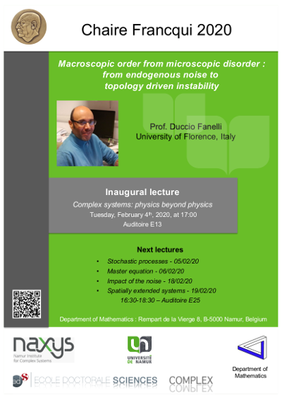About the lectures
Inaugural lecture: Complex systems: physics beyond physics
Abstract: Complex systems are systems composed of many microscopic entities, subject to mutual interactions. Starting from the microscopic rules of interaction, systems self-organize in time and in space, yielding ordered macroscopic patterns which are needed for implementing dedicated functions.
Cellular biology, chemical oscillating reactions, the organization of social communities are all examples of complex systems, covering different scales and involving distinct populations, which can be quantitatively addressed via statistical mechanics and non linear dynamics tools.
The classical approach to population dynamics relies indeed on characterizing the densities of species through a system of ordinary differential equations, which incorporates the interactions being at play. In other words, pure competition, predator-prey interactions, or even cooperative effects could be translated into specific interaction terms. Noise and other disturbances can be eventually hypothesized to alter the ideal deterministic, hence reproducible, dynamics but always acting as a macroscopic bias.
As opposed to this formulation, a different level of modeling can be invoked by focusing instead on the individual-based description, which is intrinsically stochastic. Individuals entities interact when e.g. they happen to meet and the ensuing reactions might occur with a given success rate. The system becomes probabilistic and the idealized deterministic picture can be solely recovered when considering very large populations of interacting units.
For finite size populations, demographic noise, as the probabilistic contributions are customarily referred to, acts as a source of endogenous perturbation, shaking the system from the inside. In this talk I will discuss, in simple terms and building on examples, how the noisy component of the dynamics, as stemming from the discreteness of the scrutinized sample, can yield the emergence of quasi-regular patterns.
Microscopic disorder can hence materialize in macroscopic order, a counterintruitive mechanism which could be exploited by living systems to orchestrate a multitude of different functions. If time allows, I will also make reference to networks, another source of heterogeneity which positively interferes with the ability of a multi-species system to generate coherent patterns of collective activity. This latter topic will be also addressed within the planned lectures.
lectures series: Macroscopic order from microscopic disorder: from endogenous noise to topology driven instability.
Abstract: The lectures will address the study of systems made of finite set of interacting units. We will show how endogenous noise, as stemming from the discrete nature of the examined systems, can drive the emergence of self-organized patterns, at the macroscopic level. The course aims at introducing the reference mathematical and numerical tools for facing the study of stochastic processes. A few examples from different realms, from physics to chemistry via biology and neuroscience, will be thoroughly examined to demonstrate the importance of properly accounting for the noisy component of the dynamics. Complex dynamical systems defined on heterogeneous networks will be also discussed.
Lecture 1: stochastic processes
Brownian motion from Einstein to Langevin. Basic of stochastic processes. Simple Markov processes. Application: the urn model. Analytical solution and numerical simulations.
Lecture 2 : Master equation
A birth/death stochastic model. The formalism of chemical equations. Master equation. The law of mass action and the deterministic limit. The van Kampen system size expansion. Predicting the distribution of fluctuations. Montecarlo simulations vs. theory predictions
Lecture 3 : Impact of the noise
Emerging order from endogenous noise. The concept of quasi-cyles. The linear noise approximation and the power spectra of fluctuations. A gallery of examples (biology, neuroscience) where quasi-cycles prove of interests.
Lecture 4 : Spatially extended systems
Spatially extended systems and pattern formation. The concept of Turing instability. Stochastic Turing instability. The case of systems defined on a heterogeneous network support.










